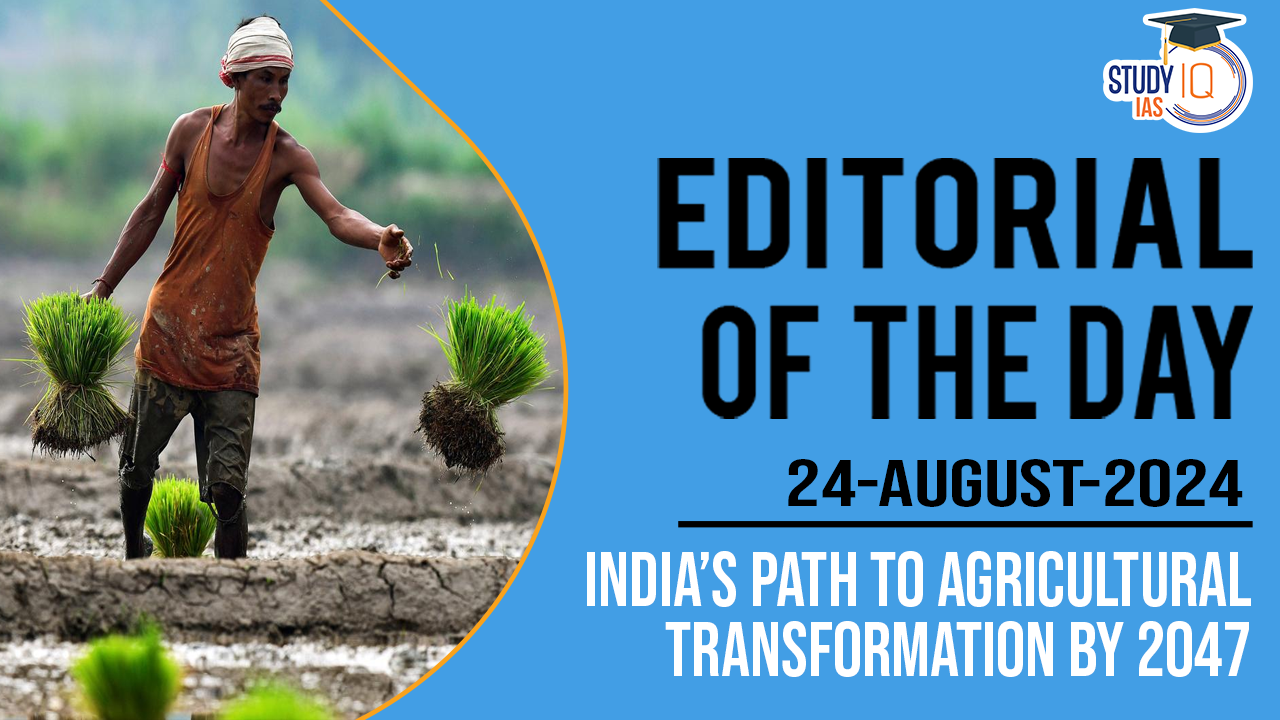Table of Contents
Context: India aims to be a developed nation by 2047, necessitating a six-fold increase in GNI and substantial advancements in sustainable agricultural practices.
Growth Of India’s Agriculture in Recent Years
- Agriculture employs nearly 46% of the workforce, it contributes only about 18% to the GDP.
- However, the agri-GDP growth for 2023-24 is just 0.7%.
- From 1991-92 to 2023-24, India’s GDP grew at an average rate of 6.1% annually, while agricultural GDP grew at 3.3%.
- During the last decade, overall GDP growth was 5.9%, but agricultural growth was only 3.6%.
- Shares of agriculture in overall GVA at current prices in FY 24 were 17.7% (Economic Survey 23-24).
| What are the Six Key Focus Areas in “Viksit Bharat@2047‟? |
Six Key Focus Areas In “Vision India@2047‟:
|
Government Initiatives
- Water Management: The Pradhan Mantri Krishi Sinchayee Yojana (PMKSY) supports water-use efficiency and has impacted 78 lakh hectares with an allocation of ₹93,068 crore for 2021-26.
- Risk Management: Under the Pradhan Mantri Fasal Bima Yojana (PMFBY), 49.5 crore farmers have been enrolled, with claims exceeding ₹1.45 lakh crore to mitigate crop losses.
- Market Access: The Electronic National Agriculture Market (eNAM) facilitates market integration through an electronic platform, aiding 1.76 million farmers and achieving a trade of ₹2.88 lakh crore as of September 2023.
- Farmer Support: The Pradhan Mantri Kisan Samman Nidhi (PM-KISAN) provides ₹6,000 yearly to farmers, benefiting over 11.8 crore individuals.
- Soil Health: The Soil Health Card (SHC) scheme has distributed over 23 crore SHCs, aiming to improve agricultural productivity by optimising soil nutrient use.
- Pest Control: The National Pest Surveillance System (NPSS) an AI-based platform launched by the Union Ministry of Agriculture and Farmer Welfare, is designed to help farmers connect with agricultural scientists and experts for effective pest control using their phones.
What are the Roadblocks For Indian Agriculture To Achieve Aspirations of Vikshit Bharat 2047?
- Climate Change and Environmental Risks: As global temperatures rise, agriculture faces increased risks from unseasonal rains, droughts, and other extreme weather events.
- These disrupt crop cycles and affect yields, posing a fundamental threat to agricultural stability and food security.
- g. Climate-related challenges such as unseasonal rains significantly impacted agricultural productivity, with agri-GDP growth plummeting to 0.7% in the 2023-24 fiscal year.
- Workforce Imbalance: Agriculture accounts for about 18% of GDP while employing nearly 46% of the workforce, showcasing low productivity and potential for economic imbalances.
- Resource Management Issues: Urgent improvements are needed in managing water use, combating soil degradation, and reducing greenhouse gas emissions from agriculture.
- g. Between 2002 and 2022, about 95% of India’s groundwater depletion occurred in north India mainly as a result of increased groundwater pumping to meet irrigation demands for crops.
- Lag in Technology and Innovation: There is a critical need for modernising agricultural practices and infrastructure to address climate challenges and enhance productivity.
- Policy Shortcomings: Current agricultural policies, such as export controls and stocking limits, reflect outdated approaches reminiscent of the 1960s and highlight the necessity for policy reforms in subsidy allocation, research funding, and improving market access.
|
Fact |
|
| Why There is Need For Strategic Planning in India’s Agriculture? |
|
Way Forward
- Adoption of Sustainable Practices: The transformation of Indian agriculture will depend on embracing sustainable methods like precision farming, the use of genetically modified crops, and sophisticated irrigation techniques such as drip and sprinkler systems.
- Investment in Research and Development: Significant funding is required in agricultural research, infrastructure, and policy development to sustainably meet increasing future demands.
- Funding and Budget Provisions: The 2024-25 budget includes an allocation of ₹20 lakh crore for targeted agricultural credit and initiates the Agriculture Accelerator Fund, demonstrating a commitment to advancing agricultural innovation and growth.
- Enhancement of Digital Infrastructure: Strengthening and expanding digital platforms such as eNAM is essential to enhance market access, provide real-time data, and ensure better pricing outcomes for farmers.


 Operation Baam: Baloch Separatist Group ...
Operation Baam: Baloch Separatist Group ...
 National Register of Indian Citizens (NR...
National Register of Indian Citizens (NR...
 World Population Day 2025, Themes, Histo...
World Population Day 2025, Themes, Histo...





















